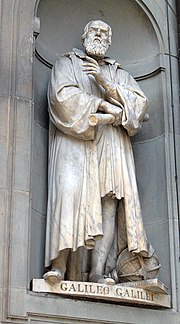Galileo Galilei was born #onthisday in 1564. Here’s a portrait from the collection http://ow.ly/IyO31
此劇海峽兩岸都有譯本: Life of Galileo (German: Leben des Galilei), also known as Galileo, is a play by the twentieth-century German dramatist Bertolt Brecht with incidental music by Hanns Eisler.
The first version of the play was written between 1938 and 1939; the second (or 'American') version was written between 1945–1947, in collaboration with Charles Laughton. The play received its first theatrical production (in German) at the Zurich Schauspielhaus, opening on 9 September 1943. This production was directed by Leonard Steckel, with set-design by Teo Otto. The cast included Steckel himself (as Galileo), Karl Paryla and Wolfgang Langhoff.
The second version (in English) opened at the Coronet Theatre in Los Angeles on 30 July 1947.[1] It was directed by Joseph Losey and Brecht, with musical direction by Serge Hovey and set-design by Robert Davison. Laughton played Galileo, with Hugo Haas as Barberini and Frances Heflin as Virginia. This production opened at the Maxine Elliott's Theatre in New York on 7 December of the same year. A third production, by the Berliner Ensemble with Ernst Busch in the title role, opened in January 1957 at the Theater am Schiffbauerdamm and was directed by Erich Engel, with set-design by Caspar Neher.[2]The play was first published in 1940.[citation needed]
A screen adaptation of the play, directed by Joseph Losey for American Film Theatre, was produced in 1975 under the title Galileo with Topol in the title role.
The plot of the play concerns the latter period of the life of Galileo Galilei, the great Italiannatural philosopher, who was persecuted by the Roman Catholic Church for the promulgation of his scientific discoveries; for details, see Galileo affair. The play embraces such themes as the conflict between dogmatism and scientific evidence, as well as interrogating the values of constancy in the face of oppression.
Contents
[hide]http://en.wikipedia.org/wiki/Galileo_Galilei
伽利略·伽利萊(Galileo Galilei,1564年2月15日-1642年1月8日)[1][2][3],義大利物理學家、數學家、天文學家及哲學家,科學革命中的重要人物。其成就包括改進望遠鏡和其所帶來的天文觀測,以及支持哥白尼的日心說。伽利略做實驗證明,感受到引力的物體並不是呈等速運動,而是呈加速度運動;物體只要不受到外力的作用,就會保持其原來的靜止狀態或勻速運動狀態不變。他又發表慣性原理闡明,未感受到外力作用的物體會保持不變其原來的靜止狀態或勻速運動狀態。伽利略被譽為「現代觀測天文學之父」[4]、「現代物理學之父」[5]、「科學之父」[5]及「現代科學之父」。[6]
著作[編輯]
1586年,伽利略出版了他的早期作品《小天平》[197]記載了一些能在空氣中或水中稱重的精密天平。[198]1606年出版印刷了《地理軍事兩用圓規使用指南》[199]介紹如何使用地理軍事兩用圓規。[200]
伽利略早期動力學---運動和力學的科學的著作包括:1590年比薩版的《論運動》[201];大約1600年帕多瓦版的《力學》[202]。《論運動》參考了亞里斯多德-阿基米德流體動力學,流體動力學認為「在一種流體介質中,重力加速度和物體超過介質的比重成比例;而在真空中,物體將按照與自身比重成比例的重力加速度下落。」《論運動》也參考了Hipparchan-Philoponan動力學。Hipparchan-Philoponan動力學認為,「動力自動消散。在經過最初的加速以後,根據物體的具體重量,真空中的自由落體將具有必不可少的極限速度。」
- 伽利略衛星;
- 月球表面粗糙的地理地質;
- 存在有大量肉眼看不到的天體,它們組成了銀河系;
- 行星與恆星外表的不同——前者看上去像是小圓盤,後者則類似小光點。
伽利略在1613年出版的《論太陽黑子》[204]中詳細描述了太陽黑子,並認為太陽和宇宙都是可以朽壞的。《論太陽黑子》中也記錄了他在1610年利用望遠鏡觀察的全部金星相位,土星奇怪的「附屬物」以及後者的神秘消失。1615年,伽利略寫成了《致大侯爵夫人克里斯蒂娜》手稿,但直到1636年才得以發表。手稿是《致凱斯泰利》的翻版,其中斥責了異端審判庭就禁止宣揚哥白尼理論的錯誤神學立場,認為後者是物理真理,與經文並不衝突。[205]。1616年,異端審判庭下達指令,禁止伽利略為哥白尼學說辯護,伽利略不得不將基於哥白尼地理的《論潮汐》[206]以私信的方式發送給紅衣主教奧思尼。[207]1619年,伽利略的學生馬里奧·古迪西出版了伽利略的演講彙編,命名為《論彗星》[208],反駁耶穌會對彗星的解釋。[209]
1623年,伽利略出版了《試金者》,攻擊亞里斯多德權威的學說,鼓勵實驗,並運用數學來支持科學理論。該書的出版獲得了巨大成功,甚至得到了一些天主教會高層的支持。[210]在《試金者》的成功發表後,伽利略於1632年出版了《關於托勒密和哥白尼兩大世界體系的對話》[211]。雖然顧及到了異端審判庭的1616年指令,但《對話》依然傾向於哥白尼理論而非地心說模型,並最終造成了伽利略受審,出版物被禁。雖然出版物被禁,伽利略依然寫成了《論兩種新科學及其數學演化》[212],並於1638年在異端審判庭管轄範圍之外的荷蘭將其出版。
伽利略出版的主要作品[編輯]
伽利略出版的主要作品如下:
- 《小天平》(1586)
- 《運動論》(1590)[213]
- 《力學》(ca. 1600)
- 《地理軍事兩用圓規使用指南》(1606)
- 《星際信使》(1610;義大利文Sidereus Nuncius)
- 《流體力學》(1612)
- 《論太陽黑子》(1613)
- 《致大侯爵夫人克里斯蒂娜》(1615; 1636年出版)
- 《論潮汐》(1616;義大利文Discorso del flusso e reflusso del mare)
- 《論彗星》(1619;義大利文Discorso Delle Comete)
- 《試金者》(1623;義大利文Il Saggiatore)
- 《關於托勒密和哥白尼兩大世界體系的對話》(1632;義大利文Dialogo dei due massimi sistemi del mondo)
- 《論兩種新科學及其數學演化》(1638;義大利文Discorsi e Dimostrazioni Matematiche, intorno a due nuove scienze)

